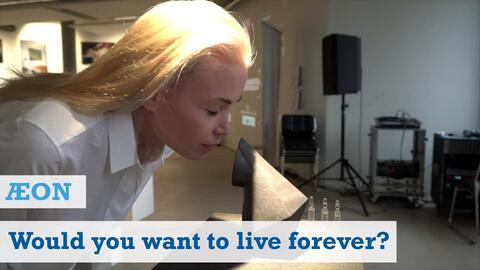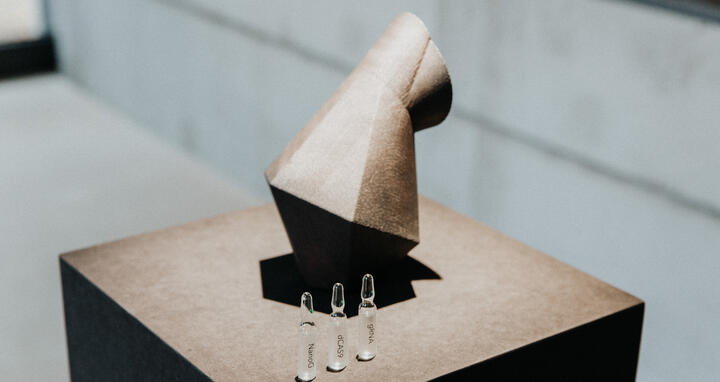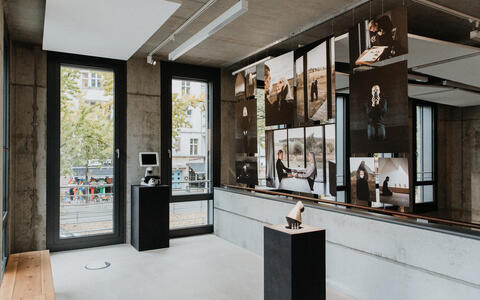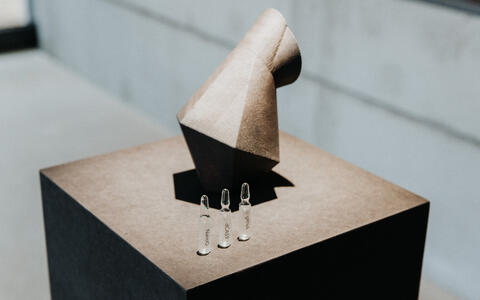Eternal youth?
Their gestures betray that they are a couple. An embrace, a touch at the dinner table, a look in the eyes. And yet one is puzzled. The woman has long, almost white hair, and her skin is furrowed with deep wrinkles. The man, on the other hand, looks as if he’s in his mid-30s.
But what separates the two is not the number of years they have lived, but the decisions they have made. For decades now, the man has been preserving his youth through daily inhalations. The woman has let nature take its course.
The dream of eternal youth is as old as humankind. Now, technologies like genome editing with CRISPR-Cas9 make stopping the aging process or at least significantly extending our longevity seem like a real possibility. The Finnish artist Emilia Tikka is interested in what this would mean for society. In her work “ÆON. Trajectories of Longevity and CRISPR,” she constructs a poetic scenario of a possible future. “I’m inviting viewers to engage with day-to-day situations that are likely to occur in such a world. The decision on whether this vision is desirable is theirs,” she says.

The result of Emilia Tikka's artist residency on the topic of gene editing at the MDC and the science behind it: the artwork, a mini symposium and a panel discussion.
In scientific labs, CRISPR is an everyday tool
We must find a common language.
For researchers, such a future is still far away. Currently, though, CRISPR-Cas9 is making their lab work easier. The genetic scissors are comparatively inexpensive, simple, and fast. They enable research teams to cut out, repair, and switch on or off sections of DNA within just a few weeks. And the more teams that are working with the genetic scissors, the faster they can fix the still existing problems. This research might even lead to the discovery of therapies for previously incurable diseases. Of course, there are still a lot of open issues. For example, when is a gene therapy using CRISPR safe enough to treat adults and children suffering from serious diseases?
Forty artists from twelve countries wanted to find out first-hand what is currently possible with CRISPR and applied for the first European artist residency on this theme. Emilia Tikka was chosen from these applicants; one thing that especially struck the curators at STATE, ORION, and the MDC about her concept was its openness to unforeseen outcomes. When she presented her idea to some 50 researchers at the MDC, though, she encountered skepticism. Some said it was impossible – and that it was practically the equivalent of saying they were working on a fountain of youth!
“We must find a common language,” says Emilia Tikka, and cites the word “speculation” as an example. She uses an approach known as speculative design to present technological developments in plausible scenarios. To do this, she must gain an understanding of the scientific details and thus find inspiration for a fictional everyday object of the future – an object that is still a long way off, but conceivable nonetheless. Her work is not based at all on wild speculation.
Eine erstrebenswerte Zukunft?
Many things were once considered impossible and unrealistic. But who really knows?
Dr. Ralf Kühn is one of those who opened his lab to Emilia Tikka. “Many things were once considered impossible and unrealistic,” says the head of the MDC’s Transgenics Platform. “But who really knows? Perhaps it will be possible to stop aging in ten or a hundred years.” Tikka agrees: “That’s why we need to have a discussion now about whether such a future is desirable. Once the technology is here, it’s too late.”
Tikka’s time at the MDC was marked by intensive discussions. These initially involved consulting with various research groups to determine what aging means for a cell, which experiments are suitable for her ideas, and how she could carry them out in just three months. But she also sought out discussion to understand the technical literature, to let ideas rise into the air like balloons, and to see what provokes opposition and what promotes reflection.
For example, the artist learned from Dr. Sebastian Diecke, head of the Pluripotent Stem Cells Platform, that a rejuvenation procedure already works in cell cultures. The Japanese scientist Shinya Yamanaka won the Nobel Prize in Medicine in 2012 for this discovery.
Rejuvenating human cells
In the beginning, there is almost no limit to what a cell can become. But the more time goes by, the more specialized a cell becomes – embryonic stem cells develop, for example, into neurons, muscles, or blood cells – thus losing their original flexibility. Contrary to what was previously assumed, Yamanaka showed that this process is reversible. He inserted four genes – c-Myc, Klf4, Oct4, and Sox2 – into the nucleus of mouse skin cells and thereby turned back the cellular clock, creating in the process induced pluripotent stem cells (iPS cells). The four genes have since been known as the Yamanaka factors.
This discovery has helped advance research. When a physician takes skin cells from a patient, these can be turned back into stem cells in the laboratory by introducing the Yamanaka factors. Researchers can use these stem cells to grow, among other things, mini-organs that have the identical genetic makeup as the patient – and to thereby look for the cause of the disease and develop effective treatments. Or they can edit the cells with CRISPR.
Tikka wanted to apply the principle of “making new from old” somewhat differently. Is a cell rejuvenated after it has been reprogrammed in a petri dish into a stem cell and then develops into a specialized cell again? A paper suggested that the hallmarks of aging disappear through this process.
Dr. Jürgen Stumm, a postdoc at the Pluripotent Stem Cells Platform, showed her the steps needed for her experiment. “But Emilia first had to make sure that the stem cells felt at home in the cell culture,” says Diecke. That alone took several days. “I’m used to doing precise work. I don’t have difficulty with that, but I didn’t imagine it would be so time-consuming,” explains Tikka.
Three glass vials, three abbreviations
When ÆON is exhibited for the first time in STATE Studio in Berlin’s Schöneberg district, two parts of the work offer a sense of these labors: A black-and-white film shows in time lapse how the stem cells turn into neurons. And viewers can also observe, under a microscope, the cells that have since been rendered non-viable.
But a fictional rejuvenation set – fully equipped with a syringe or an infusion device – is nowhere to be seen. That, according to Tikka, would be too medical for a lifestyle product, too unrealistic, too close to the whole debate on bio-hacking: “It would take the discussion in the wrong direction.” Instead, another object takes center stage. An approximately 20-centimeter high inhaler is installed on a dark pedestal, and next to the inhaler are three glass vials labeled, respectively, nanoG, dCas9, an gRNA.
A scientific paper was again the starting point for the idea; Eric Danner, a PhD student in Ralf Kühn’s lab, drew her attention to this study. It reports that the Yamanaka factors can be partially activated. The cells are then not transformed back to the embryonic state, but are instead only ‟rejuvenated.” In mice, this led to the amelioration of the cellular markers of aging and extended their life span.
Activating, not cutting
In some ways creating art and the scientific process are similar.
Based on these findings, Tikka planned a second experiment. She wanted to reactivate a Yamanaka factor in human cells using a new CRISPR version called CRISPR-dCas9 and turned to Professor Uwe Ohler’s Computational Regulatory Genomics group for advice. “We don’t use dCas9 to cut DNA,” explains Dr. Dubravka Vucicevic, a postdoc in the group. “The tool doesn’t have the ability to make cuts. But we can use it to recruit molecules in the cell to achieve our objectives ‒ for example, to activate one of the Yamanaka factors, which is what we have successfully done.”
This means the inhaler is based on gene regulation, not genome editing. “I imagine someone would have to inhale the mixture from the vials on a daily basis to actually stay young,” says Tikka. “One can’t simply stop doing it, because then all would be lost.” And what purpose do the other two vials serve? The gRNA guides the CRISPR-dCas9 to the right places in the cells. The abbreviation “nanoG” comes from the packaging material nano-gold, which CRISPR is supposed to distribute in the body.
“In some ways creating art and the scientific process are similar,” says Vucicevic. “We try to think outside the box, we work very hard to satisfy our curiosity, and we must communicate with others who have highly varied perspectives.” Her eyes move from the inhaler to the photographs, which were taken by Zuzanna Kaluzna under Tikka’s direction. They are arranged as a triptych: on the left, the woman; in the middle, the couple; on the right, the man. After decades together the couple is approaching a final parting. Would the researcher use the inhaler if she were aware of the potential effects? Vucicevic thinks for a moment and then says: “We will have to learn much more about ageing and to optimize CRISPR as a tool before we can make an informed decision on whether or not to use it to prolong our lives.” And Tikka? “At first I thought, why not? But the more I learn about it, the more doubts I have.”
Two people, two decisions.
- About the artist residency
-
-
In summer 2018, the artist Emilia Tikka spent three months as a guest in the MDC labs, collaborating with researchers to find out how CRISPR could change the future. The resulting work was exhibited at STATE Studio from late October 2018 to April 2019.
The first European artist residency on the theme of genome editing was initiated by the MDC, together with STATE, a Berlin initiative for art and open science. It was funded by the EU project ORION as a first step to initiate a dialogue with citizens on CRISPR. STATE and ORION both advocate for open science and want to encourage an open dialogue about research and its impact on society.
- About Emilia Tikka
-
-
Emilia Tikka is a designer and artist. Her interdisciplinary practice explores the philosophical dimensions and cultural implications of new technologies such as synthetic biology and CRISPR. Her methods range from object designs and installations through concepts and speculations about the future to laboratory experiments. She was recently selected for the Tokyo Art and Science Residency 2019. Born in Finland, Tikka lives and works in Berlin.
Her works have received numerous awards and been displayed at design exhibitions and art museums, including ARS Electronica in Austria, STATE Studio in Germany, the Arts Center at NYU Abu Dhabi, Västerås Art Museum in Sweden, EMMA Contemporary Art Museum in Finland, Centre of Contemporary Art Znaki Czasu (COCA) in Poland, and the Museum of Technology in Finland. Her film project Eudaimonia has been shown at film festivals such as Shorts on Tap in London and Imagine Science Films in New York, and was selected as a finalist in the European Cinematography Awards. Her work has been reviewed in the journal Nature and PLASMA Magazine and in the Süddeutsche Zeitung and Die Welt.







